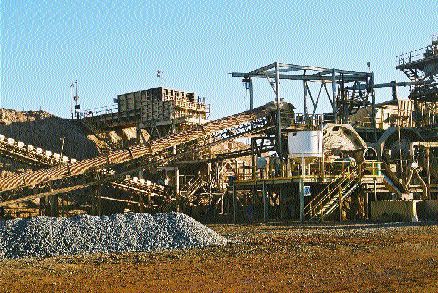Anyone dismissing the gold potential of the two Western Australian gold mining centres of Sandstone and Gidgee, which are only 90 km apart, will have to think again, as the area appears set to experience a gold rush.
Two Perth-based gold miners,
Troy began exploring the Sandstone area in 1998 and hasn’t looked back since. Legend is a relative newcomer, having acquired the Gidgee gold mine in December 2003, and yet, within the space of three months, it has transformed itself from an explorer into a gold producer.
By mid-March, Legend was not only able to report it had raised A$3.2 million through a share placement; it also made the final payment of A$1.3 million to the Gidgee mine’s previous owner, Perth-based
Legend shareholders were especially pleased to learn that routine face sampling of the Tasmania lode system at Gidgee had returned what Managing Director Murray McDonald described as bonanza gold grades (up to 539 grams gold per tonne).
A month earlier, Troy made a significant discovery near Sandstone. The new deposit, named Lord Nelson, was hailed as “the best discovery ever made by Troy.”
The two areas are in greenstone belts situated along a northeast-striking fault system.
McDonald said recent diamond drilling samples had returned 10 metres grading 92.7 grams gold per tonne, including 6 metres at 151.86 grams gold and 5.75 metres at 41.92 grams gold (the latter intercept including 1.15 metres at 202.08 grams).
The Tasmania lode system, discovered in 2002 by Abelle, has recently been substantially expanded by underground diamond drilling by Legend.
Legend acquired the Gidgee tenements for A$6.3 million.
“We knew the holes were to go through the Tasmania lode position but were surprised to see abundant visible gold in the drill core,” McDonald said. “We don’t yet know the full extent of the Tasmania system, as it comprises multiple gold lodes, but grade-control drilling will define the boundaries of the gold mineralization so that it can be mined effectively.”
The Tasmania access decline was completed in the past three months. One of the multiple lodes is now developed, with mining of the first stope scheduled to begin in mid-March. Milling of the first parcel of stope ore will follow.
McDonald said just under half of the gold produced came from the gravity circuit, and he expects the Tasmania ore to give production “a real kick along.”
Immediacy
“The benefit of an increased amount of gravity concentrate is that we get the gold almost immediately, instead of waiting for the average four-day cycle through the mill. Besides finding these significant new lodes, we’ve developed a team approach to ensuring that the lodes are quickly brought into production to feed the operating mill.”
More than 280,000 oz. gold have been produced from the Swan Bitter-Butcherbird system, to a depth of 305 metres below surface, and gold production from underground has averaged more than 1,100 oz. per vertical metre.
Gidgee production records show that grade increases with depth. In 2002-2003, the mine produced at a rate exceeding 1,200 oz. per vertical metre.
“The extremely high gold grades encountered during development of the Tasmania lode system are very encouraging,” McDonald said. “They suggest that this trend of grade increasing with depth continues below the existing workings.”
Since 1987, the Gidgee mine has produced more than 1.2 million oz. gold from open pit and underground operations.
At Sandstone, Troy’s initial Lord Nelson discovery came within days of its discovery of Lord Henry, 3.2 km to the south. Troy Chairman John Jones said Lord Nelson has the potential to transfer Troy into a larger-scale, long-life gold producer.
Troy has drilled more than 5,000 holes and spent $8.8 million on exploration over the past five years at Sandstone. The widths and grades intersected so far indicate Lord Nelson is “much superior” to the Lord Henry discovery, Jones said. He added: “The zone that has yielded both these discoveries is a most compelling target for further exploration.”
Lord Nelson was discovered in an area where there were no previous indications of gold mineralization. Drilling returned 24 metres grading 9.86 grams gold per tonne, 16 metres of 9.51 grams gold, and 17 metres of 7.67 grams gold. The program has proved that mineralization continues over 210 metres, though Troy expects the lode system will extend for 500 metres or more.
— The author is deputy editor of Gold Mining Journal, where this article first appeared.


Be the first to comment on "New gold rush in Western Australia"